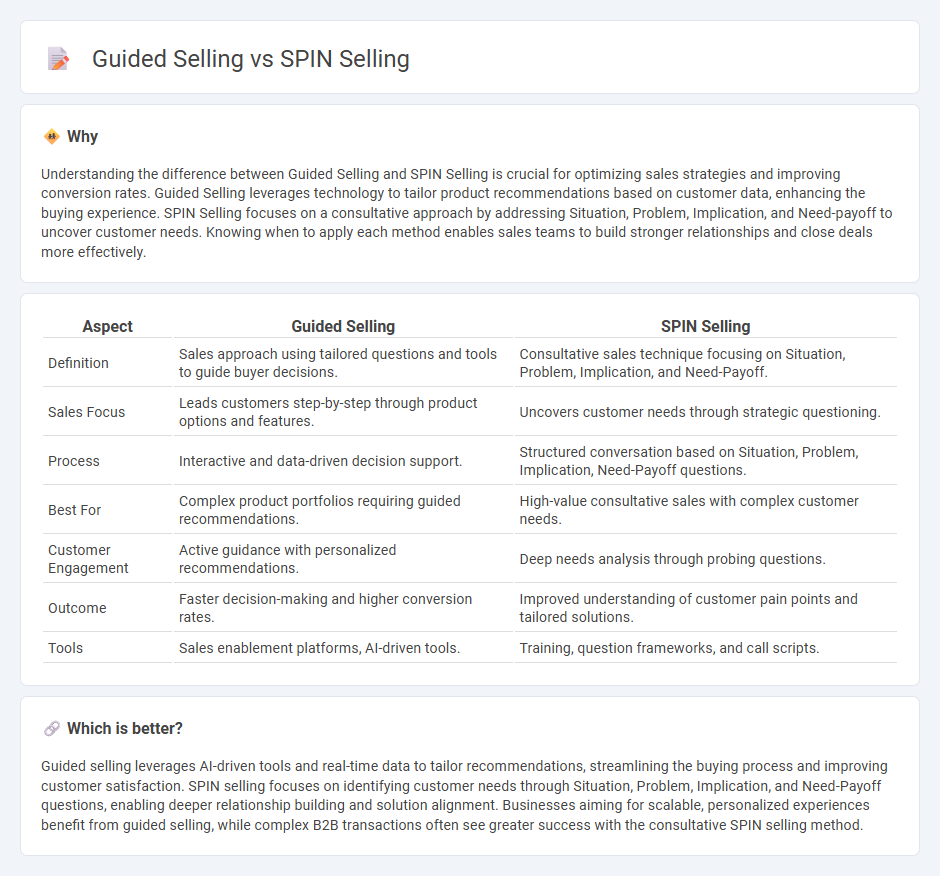
Guided selling integrates intelligent tools and data-driven insights to tailor the sales process, enhancing customer experience and boosting close rates. SPIN selling focuses on situational, problem, implication, and need-payoff questions to uncover deep client needs and drive value-based solutions. Explore more to understand which method suits your sales strategy best.
Why it is important
Understanding the difference between Guided Selling and SPIN Selling is crucial for optimizing sales strategies and improving conversion rates. Guided Selling leverages technology to tailor product recommendations based on customer data, enhancing the buying experience. SPIN Selling focuses on a consultative approach by addressing Situation, Problem, Implication, and Need-payoff to uncover customer needs. Knowing when to apply each method enables sales teams to build stronger relationships and close deals more effectively.
Comparison Table
| Aspect | Guided Selling | SPIN Selling |
|---|---|---|
| Definition | Sales approach using tailored questions and tools to guide buyer decisions. | Consultative sales technique focusing on Situation, Problem, Implication, and Need-Payoff. |
| Sales Focus | Leads customers step-by-step through product options and features. | Uncovers customer needs through strategic questioning. |
| Process | Interactive and data-driven decision support. | Structured conversation based on Situation, Problem, Implication, Need-Payoff questions. |
| Best For | Complex product portfolios requiring guided recommendations. | High-value consultative sales with complex customer needs. |
| Customer Engagement | Active guidance with personalized recommendations. | Deep needs analysis through probing questions. |
| Outcome | Faster decision-making and higher conversion rates. | Improved understanding of customer pain points and tailored solutions. |
| Tools | Sales enablement platforms, AI-driven tools. | Training, question frameworks, and call scripts. |
Which is better?
Guided selling leverages AI-driven tools and real-time data to tailor recommendations, streamlining the buying process and improving customer satisfaction. SPIN selling focuses on identifying customer needs through Situation, Problem, Implication, and Need-Payoff questions, enabling deeper relationship building and solution alignment. Businesses aiming for scalable, personalized experiences benefit from guided selling, while complex B2B transactions often see greater success with the consultative SPIN selling method.
Connection
Guided selling enhances SPIN selling by providing real-time, data-driven prompts that align with the SPIN framework's focus on Situation, Problem, Implication, and Need-payoff questions. This integration helps sales professionals identify customer pain points and tailor their inquiries to uncover deeper needs, improving the accuracy and effectiveness of buyer engagement. Leveraging AI-powered guided selling tools increases conversion rates by ensuring SPIN selling techniques are consistently applied throughout the customer journey.
Key Terms
**SPIN Selling:**
SPIN Selling emphasizes understanding customer needs through four types of questions: Situation, Problem, Implication, and Need-Payoff, facilitating deeper insights into client challenges and motivations. This consultative sales approach drives higher conversion rates by aligning solutions with specific pain points and business goals. Explore how SPIN Selling can enhance your sales strategy and customer engagement.
Situation Questions
Situation questions in SPIN selling aim to gather contextual information about the buyer's current processes, environment, and challenges to tailor the sales approach effectively. Guided selling, on the other hand, uses interactive tools and algorithms to ask targeted situation questions that streamline product recommendations based on real-time customer inputs. Explore the detailed differences and benefits of each approach to enhance your sales strategy.
Problem Questions
SPIN Selling emphasizes Problem Questions to uncover customer pain points and challenges, facilitating deeper understanding of their needs during the sales process. Guided Selling integrates these questions within a structured digital framework, enabling sales teams to tailor recommendations and solutions effectively. Explore how mastering Problem Questions can elevate your sales strategy by diving deeper into both methodologies.
Source and External Links
What is the SPIN Sales Methodology? - Sales Enablement Collective - SPIN selling is a customer-focused sales method that uses four types of questions (Situation, Problem, Implication, Need-Payoff) to build rapport, understand prospects' pain points, and sell from an informed position rather than rushing to close.
The SPIN Selling Method -- I Took a Deep Dive so You Don't Have to - HubSpot - Developed by Neil Rackham, SPIN selling is a research-backed framework focused on understanding buyer needs through a sequence of Situation, Problem, Implication, and Need-Payoff questions that guide the seller to effectively close deals.
The 4 Steps to SPIN Selling | Lucidchart - SPIN Selling is a sales technique involving a specific order of question types--Situation, Problem, Implication, and Need-Payoff--designed to discover customer needs deeply and lead to a successful sale by focusing on problem implications and solution benefits.
 dowidth.com
dowidth.com